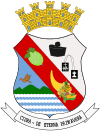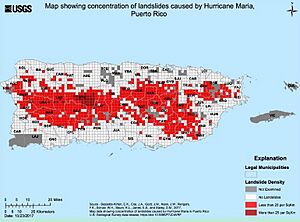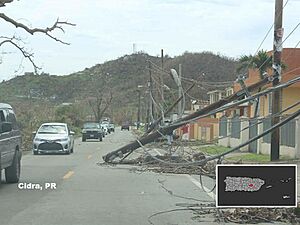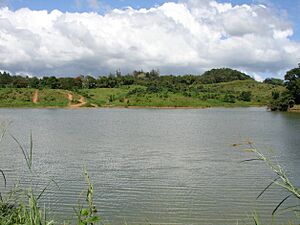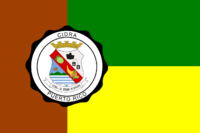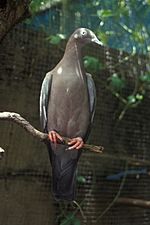Cidra, Puerto Rico facts for kids
Quick facts for kids
Cidra
Municipio Autónomo de Cidra
|
|||
|---|---|---|---|
|
Town and Municipality
|
|||
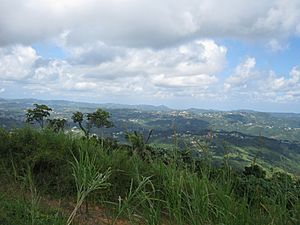 |
|||
|
|||
| Nicknames:
"La Ciudad de la Eterna Primavera" (City of Eternal Spring), "El Pueblo de la Paloma Sabanera"
|
|||
| Anthem: "Del corazón de Puerto Rico nació Cidra" | |||

Map of Puerto Rico highlighting Cidra Municipality
|
|||
| Sovereign state | |||
| Commonwealth | |||
| Settled | 1795 | ||
| Founded | October 1, 1809 | ||
| Founded by | Bibiana Vázquez | ||
| Barrios | |||
| Area | |||
| • Total | 36.46 sq mi (94.42 km2) | ||
| • Land | 36 sq mi (94 km2) | ||
| • Water | 0.16 sq mi (.42 km2) | ||
| Population
(2020)
|
|||
| • Total | 39,970 | ||
| • Rank | 22nd in Puerto Rico | ||
| • Density | 1,096.40/sq mi (423.32/km2) | ||
| Demonym(s) | Cidreños | ||
| Time zone | UTC-4 (AST) | ||
| ZIP Code |
00739
|
||
| Area code(s) | 787/939 | ||
| Major routes | |||
| GNIS feature ID | 1610092 | ||
Cidra (Spanish pronunciation: [ˈsiðɾa]) is a town and municipality in Puerto Rico. It is located in the central part of the island. Cidra is north of Cayey and south of Comerío and Aguas Buenas. To its east is Caguas, and to its west are Aibonito and Barranquitas.
The town is divided into 12 areas called barrios, plus the downtown area known as Cidra Pueblo. Cidra is part of the larger San Juan-Caguas-Guaynabo Metropolitan Statistical Area.
Cidra is famous for its nicknames: "El Pueblo de la Eterna Primavera" (which means "Town of the Eternal Spring") and "El Pueblo de la Paloma Sabanera" ("Town of the Plain Pigeon").
Contents
History of Cidra
The area where Cidra is located today was once part of the Cubuy region, home to the Taíno tribe. Their leader was a chief named Caguax.
How Cidra Started
There isn't much information about people living here right after the Spanish arrived. But around 1795, a man from Catalonia, Spain, named Frujols, built a small church. A village grew around this church.
This village was first part of Cayey. In 1807, the people living there asked the Governor for permission to start their own town. In 1809, a kind landowner named Bibiana Vázquez gave the land needed. Governor Salvador Meléndez approved the request, and Cidra became an independent town.
The name Cidra is thought to come from the citron fruit, which grew a lot in this area. When Cidra was founded, it had 26 houses and 11 huts. Over the next few years, a church and a city hall were built. By 1822, Cidra even had two public schools.
Cidra in the 1900s
After the Spanish–American War, Puerto Rico became a territory of the United States in 1898. In 1899, the first US census showed that Cidra had 7,552 people.
For a short time in 1902, Cidra became part of Cayey again. But in 1905, a new law made Cidra an independent municipality once more.
Hurricane Maria's Impact
On September 20, 2017, Hurricane Maria, a very strong storm, hit Puerto Rico. It caused many landslides in Cidra. Some parts of Cidra had more than 25 landslides per square kilometer!
After the hurricane, people in Cidra worked together to clear roads, especially in high-up areas like Rabanal, Arena, and Ceiba. Many homes lost their roofs, and some people never got money to fix them.
An old radio antenna in Cidra survived the storm. This was very important because 92.7% of other towers in Puerto Rico were destroyed. It helped people in Cidra communicate when other systems were down. Power was not fully restored to Cidra until six months after the hurricane.
Geography and Nature
Cidra is located on a hill in the eastern part of the Central Mountain Range. It is a small municipality, covering about 36 square miles (94 square kilometers).
Water Bodies
Cidra has a main water source called Lago de Cidra (Cidra Lake). This lake was built in 1946 and provides water to many parts of the island. Several rivers and creeks also flow through Cidra, like the Arroyata, Bayamón, and Río de la Plata.
Animals of Cidra
Cidra is known for being a home to the paloma sabanera, a type of pigeon that is at risk of extinction. These birds are mostly found in Cidra and nearby towns. You can also find iguanas around Lago de Cidra. They are an invasive species, meaning they are not native to the area and can sometimes cause problems for local wildlife.
Barrios of Cidra
Like all towns in Puerto Rico, Cidra is divided into smaller areas called barrios. The main town area, with the municipal buildings and church, is called "el pueblo".
Fun Places to Visit
Even though Cidra isn't a major tourist spot, it has some interesting places. In the town center, you can see historic buildings like the Parroquia Nuestra Señora del Carmen church and the Iberia Theater. Both were built in the early 1900s.
Outside the town, you can visit Lago de Cidra and Perico's Waterfalls. Frog's Rock and Hamacas Bridge are also popular spots.
A children's park called el Parque del Niño was updated in 2019. It now has water features and a skatepark, which sounds like a lot of fun!
The Puerto Rico Tourism Company suggests visiting Destilería Club Caribe, Mirador del Lago de Cidra (a viewpoint overlooking the lake), and Parque del Niño in Cidra.
Economy and Jobs
Historically, Cidra's economy depended on agriculture. Farmers grew coffee, tobacco, and various fruits. Cattle ranching was also important. In recent years, companies that make medicines (pharmaceuticals) and clothes have also become part of Cidra's economy.
Culture and Events
Festivals and Celebrations
Cidra has a special festival in July called the Fiestas Patronales de Nuestra Sra. del Carmen. This is a religious and cultural celebration for the town's patron saint. It usually includes parades, games, local crafts, rides, traditional food, and live music.
Other cultural events in Cidra include:
- Myrna Vázquez Week - held in February
- Paloma Sabanera Festival - held in early December
Religion in Cidra
Cidra has several churches. The main Catholic church, Parroquia Nuestra Señora del Carmen, started in 1813. The original building was damaged by earthquakes but was rebuilt by 1952. The Virgin Mary is Cidra's patron saint.
The First Baptist Church in Cidra was founded in 1903. Its first wooden building was destroyed by a hurricane in 1928 but was rebuilt with stronger materials.
Sports in Cidra
Cidra doesn't have a professional sports team, but it has a very successful amateur baseball team called the Bravos de Cidra. They play in the Puerto Rican Amateur Baseball Federation. The Bravos have won many championships. Their home field is the Jesús María Freire Stadium.
Several famous athletes from Puerto Rico were born in Cidra. These include former MLB players Luis Rivera and Luis López. Flor Meléndez, a former coach for the Puerto Rico men's national basketball team, and boxer José Pedraza are also from Cidra.
Famous People from Cidra
- Pura Belpré - A famous storyteller and librarian.
- Vicente Carattini - A singer and composer known for Puerto Rican Christmas songs.
- Isabel Freire de Matos - A writer, educator, journalist, and activist for Puerto Rican independence.
- Antonio Torres Pérez (Pancholo) - An actor and comedian.
- Felito Félix - A singer.
- Carmen Vazquez Rivera - A head nurse and decorated veteran who served in the US Army and Air Force during World War II and the Korean War.
Population Facts
| Historical population | |||
|---|---|---|---|
| Census | Pop. | %± | |
| 1900 | 7,552 | — | |
| 1910 | 10,595 | 40.3% | |
| 1920 | 14,789 | 39.6% | |
| 1930 | 19,662 | 33.0% | |
| 1940 | 20,392 | 3.7% | |
| 1950 | 20,491 | 0.5% | |
| 1960 | 21,891 | 6.8% | |
| 1970 | 23,892 | 9.1% | |
| 1980 | 28,365 | 18.7% | |
| 1990 | 35,601 | 25.5% | |
| 2000 | 42,753 | 20.1% | |
| 2010 | 43,480 | 1.7% | |
| 2020 | 39,970 | −8.1% | |
| U.S. Decennial Census 1899 (shown as 1900) 1910-1930 1930-1950 1960-2000 2010 2020 |
|||
Cidra's population grew a lot during the 1900s, increasing by over 200% since 1899. In 2010, about 43,480 people lived there. The 2020 census showed a slight decrease to 39,970 residents.
According to the 2010 Census, most people in Cidra (77%) identify as White, and 8.3% as African-American. About 48.9% of the population are males, and 51.1% are females. Also, 25% of the people are under 18 years old.
Symbols of Cidra
Cidra has an official flag and a coat of arms. These symbols were designed by J.J. Santa Pinter and approved in 1975.
Flag and Coat of Arms
The flag of Cidra has a brown stripe on the left side. To its right, there are two equal horizontal stripes: green on top and yellow (or golden) on the bottom.
- The golden color stands for the rich fruits grown in Cidra and its water sources. It also represents the spiritual wealth of the area.
- The green color symbolizes the green landscapes you can see in Cidra all year round. This is why the town is called the "Town of the Eternal Spring."
- The brown color represents the Virgin Mary, who is the town's patron saint. It also stands for the Paloma sabanera, a bird commonly seen in the area.
Some versions of the flag also show the coat of arms on the left side. The coat of arms has a red band going across it. On this band, there's a golden citrus fruit, which might be why the town is named Cidra. There's also a cornucopia (a horn of plenty) filled with fruits, showing that Cidra is a big producer of fruits.
The top part of the shield is white or silver. It has a black scapular (a religious item) representing the Virgin Mary, and a black bishop's hat for San Juan Nepomuceno, a bishop and martyr. The bottom part is mostly blue with a brown pigeon flying over mountains, showing Cidra's location in the Central Mountain Range. There are also silver water waves. The whole shield is topped with a three-tower crown, which is common for town seals in Puerto Rico.
Town Nicknames
Cidra is best known by two nicknames:
- "Town of the Eternal Spring" because of its pleasant, cool temperatures.
- "Town of the Plain Pigeon" because many of these special birds live there.
Education in Cidra
Cidra has about 15 public schools. The Puerto Rico Department of Education manages all schools in the municipality.
Elementary Schools
- Ceiba Nueva - Ceiba
- Luis Muñoz Rivera - Cidra
- Escuela Regino Vega Martínez - (Formerly: Escuela Nueva Santa Clara, Escuela Nueva de Arenas)
- Violeta Reyes (PreK-8) - Río Abajo
Junior High School
- Jesús T. Piñero (7-8) - Cidra
Mixed Schools (Elementary/Junior High)
- Clemencia Meléndez Santos - Rabanal
- Certenejas (I & II) - Certenejas
- Juan D. Stubbe - Bayamón
High Schools
- Ana J. Candelas - Sud
- Luis Muñoz Iglesias - Cidra
- Vocacional Ruth Evelyn Cruz - Sud
- Escuela Especializada en Música Jesús T. Piñero - Pueblo
Getting Around Cidra
The main road to Cidra is Road 172, which connects from Puerto Rico Highway 52. It takes about 40 minutes to drive from the capital city to Cidra. Other roads leading to the town are #787 and #173.
Cidra also has 19 bridges.
See also
 In Spanish: Cidra (Puerto Rico) para niños
In Spanish: Cidra (Puerto Rico) para niños



